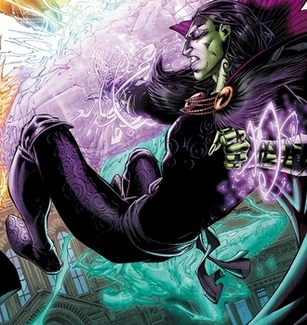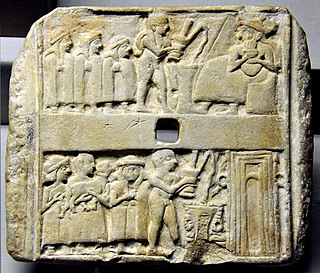Related Research Articles

Chinese mythology is mythology that has been passed down in oral form or recorded in literature throughout the area now known as Greater China. Chinese mythology encompasses a diverse array of myths derived from regional and cultural traditions. Populated with engaging narratives featuring extraordinary individuals and beings endowed with magical powers, these stories often unfold in fantastical mythological realms or historical epochs. Similar to numerous other mythologies, Chinese mythology has historically been regarded, at least partially, as a factual record of the past.

Hārītī (Sanskrit), also known as Chinese: 鬼子母(神); pinyin: Guǐzǐmǔ(shén), Japanese: 鬼子母神, romanized: Kishimojin, is both a revered goddess and demon, depending on the Buddhist tradition. She is one of the Twenty-Four Protective Deities of Mahayana Buddhism.

In Mesopotamian religion, Tiamat is a primordial goddess of the sea, mating with Abzû, the god of the groundwater, to produce younger gods. She is the symbol of the chaos of primordial creation. She is referred to as a woman and described as "the glistening one". It is suggested that there are two parts to the Tiamat mythos. In the first, she is a creator goddess, through a sacred marriage between different waters, peacefully creating the cosmos through successive generations. In the second Chaoskampf Tiamat is considered the monstrous embodiment of primordial chaos. Some sources identify her with images of a sea serpent or dragon.

Nüwa, also read Nügua, is a mother goddess, culture hero, and/or member of the Three Sovereigns of Chinese mythology. She is a goddess in Chinese folk religion, Chinese Buddhism, Confucianism and Taoism. She is credited with creating humanity and repairing the Pillar of Heaven.

The Goddess movement is a revivalistic Neopagan religious movement which includes spiritual beliefs and practices that emerged predominantly in the Western world during the 1970s. The movement grew as a reaction both against Abrahamic religions, which exclusively have gods with whom are referred by masculine grammatical articles and pronouns, and secularism. It revolves around Goddess worship and the veneration for the divine feminine, and may include a focus on women or on one or more understandings of gender or femininity.
Georgian mythology refers to the mythology of pre-Christian Georgians, an indigenous Caucasian ethnic group native to Georgia and the South Caucasus. The mythology of the Kartvelian peoples is believed by many scholars to have formed part of the religions of the kingdoms of Diauehi, Colchis and Iberia.

Philippine mythology is rooted in the many indigenous Philippine folk religions. Philippine mythology exhibits influence from Indonesian, Hindu, Muslim, Shinto, Buddhist, and Christian traditions.

Mother Nature is a personification of nature that focuses on the life-giving and nurturing aspects of nature by embodying it, in the form of a mother or mother goddess.

Donna Troy is a superhero appearing in American comic books published by DC Comics. She is the original Wonder Girl and later temporarily adopts another identity, Troia. Created by Bob Haney and Bruno Premiani, she first appeared in The Brave and the Bold #60. Donna has been commonly featured in stories involving the Teen Titans, which she originally joined during their second adventure and is since depicted as a founding member of the team.

Snakes are a common occurrence in myths for a multitude of cultures. The Hopi people of North America viewed snakes as symbols of healing, transformation, and fertility. Snakes in Mexican folk culture tell about the fear of the snake to the pregnant women where the snake attacks the umbilical cord. The Great Goddess often had snakes as her familiars—sometimes twining around her sacred staff, as in ancient Crete—and they were worshipped as guardians of her mysteries of birth and regeneration. Although not entirely a snake, the plumed serpent, Quetzalcoatl, in Mesoamerican culture, particularly Mayan and Aztec, held a multitude of roles as a deity. He was viewed as a twin entity which embodied that of god and man and equally man and serpent, yet was closely associated with fertility. In ancient Aztec mythology, Quetzalcoatl was the son of the fertility earth goddess, Cihuacoatl, and cloud serpent and hunting god, Maxicoat. His roles took the form of everything from bringer of morning winds and bright daylight for healthy crops, to a sea god capable of bringing on great floods. As shown in the images there are images of the sky serpent with its tail in its mouth, it is believed to be a reverence to the sun, for which Quetzalcoatl was also closely linked.
Spider Grandmother is an important figure in the mythology, oral traditions and folklore of many Native American cultures, especially in the Southwestern United States.

The Titans of Myth are mythological deities who appear in the Teen Titans and Wonder Woman comic book series by DC Comics.

Wotan is a fictional supervillain featured in American comic books published by DC Comics. The character, created by Gardner Fox and Howard Sherman, made their first appearance in More Fun Comics #55 in 1940. Wotan is frequently portrayed as the primary antagonist of Doctor Fate. Originally a female who obtained her powers through sorcery, Wotan later underwent reincarnation in a male form. Adopting the name "Wotan" from Germanic and Norse legends, the character developed a strong desire for power, leading to conflicts with Doctor Fate. Following the New 52 reboot, a new version of the character named Karel Wotan was introduced in the Earth 2 universe. Karel shares a similar background and possesses green skin as a result of a scar inflicted by Nabu. Seeking vengeance for this injury, Karel assumes the identity of Wotan. The original incarnation of Wotan briefly reappeared in the DC Rebirth storyline.

Sumerian religion was the religion practiced by the people of Sumer, the first literate civilization of ancient Mesopotamia. The Sumerians regarded their divinities as responsible for all matters pertaining to the natural and social orders.

Inca mythology is the universe of legends and collective memory of the Inca civilization, which took place in the current territories of Colombia, Ecuador, Peru, Bolivia, Chile, and Argentina, incorporating in the first instance, systematically, the territories of the central highlands of Peru to the north.

The mythology of Indonesia is very diverse, the Indonesian people consisting of hundreds of ethnic groups, each with their own myths and legends that explain the origin of their people, the tales of their ancestors and the demons or deities in their belief systems. The tendency to syncretize by overlying older traditions with newer foreign ideas has occurred. For example, the older ancestral mythology might be merged with foreign mythology, such as Hindu, Islam, or Christian biblical mythology.
Ngewo is the supreme creator god of the people of Mende from Sierra Leone.
Bemba is the creator god in the traditional religion of the Bambara people of Mali. The name is used to refer to Bemba, who is portrayed as a god consisting of four distinct beings and is sometimes used to refer to one of its members, Pemba. Although Bemba is often referred to as male, the union of these four beings as Bemba is hermaphroditic, with the male aspects represented by Pemba and Ndomadyiri, while the female aspects are represented by Nyale and Faro.
Ogboinba is a mythical sorceress who appears in the folklore of the Ijo (Ijaw) people of Nigeria. She is noted for attempting to use her supernatural powers to challenge Woyengi, the supreme deity of the Ijo, into changing her chosen fate of childlessness. While escaping Woyengi's anger, she enters the eyes of a pregnant woman, and remains trapped there. The Ijo say that when you look into the eyes of another person, it is Ogboinba who looks back at you.
References
- 1 2 3 4 Lynch, Patricia Ann; Roberts, Jeremy (2010). African Mythology, A to Z. Infobase Publishing. ISBN 978-1-4381-3133-7.
- 1 2 3 4 5 Okpewho, Isidore (1979). "Poetry and Pattern: Structural Analysis of an Ijo Creation Myth". The Journal of American Folklore. 92 (365): 302–325. doi:10.2307/539417. ISSN 0021-8715. JSTOR 539417.
- 1 2 3 4 "Woyengi | Ijo deity". Encyclopedia Britannica. Retrieved 2021-03-02.
- 1 2 "Ogboinba and the Creation Stone". Oxford Reference. Retrieved 2021-03-02.